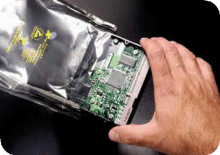Electrostatic Discharge is the sudden discharge of static electricity to ground. Sensitive components, such as desktop or notebook disk drives or Solid State Drives, may be damaged if they are in the current path when the discharge occurs. Special precautions should always be taken when handling any device that may be damaged by static electricity.
ESD damage occurs when a charge on a hand or tool finds a path of lesser resistance for itself to a drive. As the current flows to the drive, if the maximum amount of energy that parts of the drive can dissipate is less than the energy of the charge, then damage may occur. In a desktop or notebook disk drive, the small metal foil-like paths in the circuit board, which are made to handle minute amounts of voltage, can be blown apart. If the damage is only partial, the signal which is supposed to go through the path may become intermittent, causing degradation of the signal.
ESD Prevention

Ideally, your drive is shipped in a special bag designed to prevent ESD. Keep the drive in the bag until you are ready to install it, then open the bag by hand or cut the top with a pair of scissors. Never insert a metal tool or knife into the bag and rip it open.
When the drive is installed, put the bag away and do not lose it. If you ever need to ship the drive back or transport it, the bag is your first line of protection from ESD. The bag can also be useful for packing materials. See our Warranty Services page for specific instructions about packing drives.
- Keep your drive in the ESD bag until you need to handle it.
- Always wear an ESD wrist strap (available at most computer or electrical supply stores) grounded to an unpainted surface on the chassis of your computer.
- If a wrist strap is unavailable, touch an unpainted surface on the chassis of your computer before handling your drive.
- Only touch the connector pins on your drive with the proper cabling ends or jumpers. Never use a bare finger or non-insulated tool.
- Protect your drive from sources of high voltage power such as fans or vacuum cleaners.
- Never try to plug a power or data cable into a non-hot-swappable drive unless power to the box is completely off.
 Seagate, Samsung, and Maxtor-brand external and network-attached storage drives are protected against ESD by their enclosures, so this article only applies to bare drives such as desktop and notebook internal drives and Solid State Drives.
Seagate, Samsung, and Maxtor-brand external and network-attached storage drives are protected against ESD by their enclosures, so this article only applies to bare drives such as desktop and notebook internal drives and Solid State Drives.






